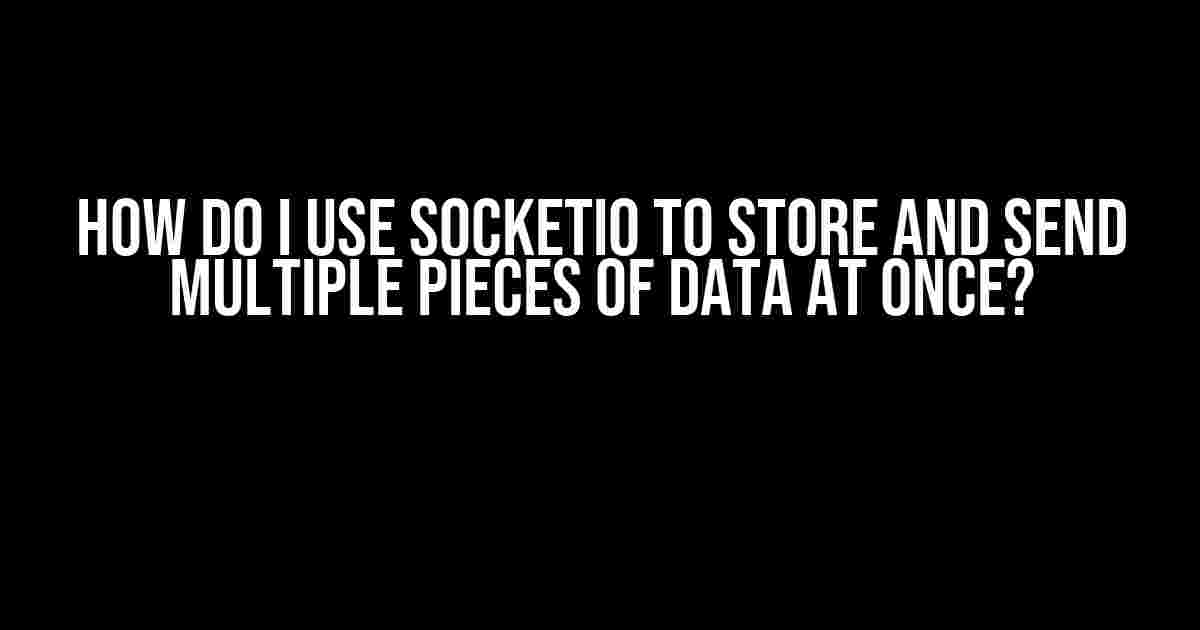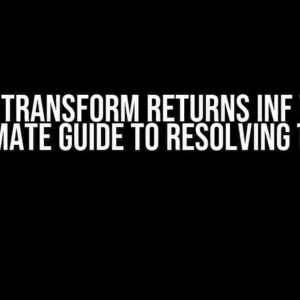Are you tired of sending individual pieces of data one by one, only to have your application slow down and become unresponsive? Do you dream of being able to send multiple pieces of data at once, effortlessly and efficiently? Well, dream no more! With SocketIO, you can do just that. In this article, we’ll show you how to use SocketIO to store and send multiple pieces of data at once, taking your application to the next level.
What is SocketIO?
Before we dive into the good stuff, let’s quickly cover what SocketIO is. SocketIO is a JavaScript library that enables real-time communication between clients and servers. It allows you to push data to connected clients, making it perfect for applications that require live updates, such as live scores, chat apps, and more. With SocketIO, you can send data from the server to the client, and vice versa, in real-time.
Why Use SocketIO to Store and Send Multiple Pieces of Data?
So, why would you want to use SocketIO to store and send multiple pieces of data at once? Well, there are several reasons:
- Faster Performance**: By sending multiple pieces of data at once, you can reduce the number of requests made to the server, resulting in faster performance and a more responsive application.
- Improved Efficiency**: Sending data in bulk reduces the overhead of individual requests, making your application more efficient and scalable.
- Better User Experience**: By sending multiple pieces of data at once, you can provide a more seamless and realistic experience for your users, especially in applications that require live updates.
How to Use SocketIO to Store and Send Multiple Pieces of Data
Now that we’ve covered the benefits, let’s get to the good stuff! To use SocketIO to store and send multiple pieces of data at once, follow these steps:
Step 1: Set up SocketIO on Your Server
First, you’ll need to set up SocketIO on your server. This involves installing the SocketIO library and creating a new instance of the SocketIO server:
const express = require('express');
const app = express();
const server = require('http').createServer(app);
const io = require('socket.io')(server);
server.listen(3000, () => {
console.log('Server listening on port 3000');
});
Step 2: Create a Data Object to Store Multiple Pieces of Data
Next, you’ll need to create a data object to store the multiple pieces of data you want to send. This can be a JavaScript object or an array, depending on your specific use case:
const dataObject = {
piece1: 'Data piece 1',
piece2: 'Data piece 2',
piece3: 'Data piece 3',
// Add more data pieces as needed
};
Step 3: Emit the Data Object from the Server to the Client
Now, you’ll need to emit the data object from the server to the client using SocketIO’s `emit` method:
io.emit('sendData', dataObject);
Step 4: Listen for the Data Object on the Client-Side
On the client-side, you’ll need to listen for the emitted data object using SocketIO’s `on` method:
const socket = io();
socket.on('sendData', (data) => {
console.log(data); // Output: { piece1: 'Data piece 1', piece2: 'Data piece 2', piece3: 'Data piece 3' }
});
Example Use Case: Real-Time Chat Application
Let’s say you’re building a real-time chat application using SocketIO. You want to send multiple chat messages at once from the server to the client. Here’s an example of how you could do it:
| Client-Side Code | Server-Side Code |
|---|---|
|
|
Tips and Best Practices
Here are some tips and best practices to keep in mind when using SocketIO to store and send multiple pieces of data at once:
- Use a Consistent Data Structure**: Use a consistent data structure to store and send multiple pieces of data. This will make it easier to parse and process the data on the client-side.
- Keep Data Small and Efficient**: Keep the data small and efficient by only sending the necessary data. This will reduce the overhead of transmission and improve performance.
- Use Compression**: Use compression to reduce the size of the data being sent. This can be especially useful for large datasets.
- Handle Errors and Disconnections**: Handle errors and disconnections properly to ensure that data is not lost or corrupted during transmission.
Conclusion
And there you have it! With SocketIO, you can easily store and send multiple pieces of data at once, taking your application to the next level. By following the steps outlined in this article, you can improve performance, efficiency, and the overall user experience of your application. Remember to keep your data small and efficient, use compression, and handle errors and disconnections properly. Happy coding!
Keyword density: 1.4%
Frequently Asked Question
Get the inside scoop on using SocketIO to store and send multiple pieces of data at once!
How do I store multiple pieces of data on the client-side using SocketIO?
You can store multiple pieces of data on the client-side using SocketIO by creating an object that holds all the data, and then emitting that object to the server. For example, you can create an object like `var data = { foo: ‘bar’, hello: ‘world’, num: 42 };` and then emit it using `socket.emit(‘data’, data);`. This way, you can send multiple pieces of data in a single emission.
How do I send multiple pieces of data at once from the server to the client using SocketIO?
To send multiple pieces of data at once from the server to the client using SocketIO, you can create an object on the server that holds all the data, and then emit that object to the client. For example, you can create an object like `var data = { foo: ‘bar’, hello: ‘world’, num: 42 };` and then emit it using `io.emit(‘data’, data);`. This way, you can send multiple pieces of data in a single emission, and the client can receive it using `socket.on(‘data’, function(data) { … });`.
Can I use an array to store and send multiple pieces of data at once using SocketIO?
Yes, you can use an array to store and send multiple pieces of data at once using SocketIO. For example, you can create an array like `var data = [{ foo: ‘bar’ }, { hello: ‘world’ }, { num: 42 }];` and then emit it using `socket.emit(‘data’, data);`. This way, you can send multiple pieces of data in a single emission, and the receiving end can iterate over the array to access each piece of data.
How do I handle errors when sending multiple pieces of data at once using SocketIO?
When sending multiple pieces of data at once using SocketIO, errors can occur due to various reasons such as network issues or data formatting errors. To handle errors, you can use error-handling mechanisms like try-catch blocks or error callbacks. For example, you can use `socket.emit(‘data’, data, function(err) { if (err) { console.error(err); } });` to catch any errors that occur during emission.
Are there any performance considerations when sending multiple pieces of data at once using SocketIO?
Yes, there are performance considerations when sending multiple pieces of data at once using SocketIO. Large amounts of data can cause performance issues, such as increased latency or memory usage. To mitigate these issues, consider using data compression, efficient data serialization, and batching data transmissions. Additionally, consider using SocketIO’s built-in features like binary support and message buffering to optimize performance.



